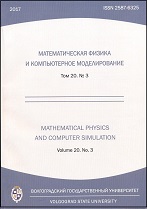|
Mathematics and mechanics
Homogenization of the problem of admixture diffusion from a reservoir into absolutely hard porous soil
O. A. Galtseva
National Research University "Belgorod State University"
Abstract:
The paper is devoted to the study of the initial-boundary value problem for a system of equations describing the motion of a viscous incompressible fluid in an absolutely rigid porous medium. The system under consideration is supplemented by the equation of admixture diffusion in pores of hard soil. The process is complicated by the motion in water reservoir. The admixture density depends on its concentration. Macroscopic analogs of the original microscopic equations are derived.
The process of admixture diffusion from a water reservoir into a porous soil is considered in the region $\Omega^0$ (water reservoir) and $\Omega$ (porous medium), separated by the common boundary $S^0$. The fluid motion in $\Omega^0$ for $t>0$ is described by the stationary system of the Stokes equations and and fluid motion in the porous medium $\Omega$ is described by the continuity equation, by the balance equation and the admixture diffusion equation, where $\mathbf{v}(\mathbf{x},t)=(v_{1}(\mathbf{x},t),v_{2}(\mathbf{x},t))$ is the velosity of admixture, $p(\mathbf{x},t)$ - the pressure, $c^{\varepsilon}(\mathbf{x},t)$ - the admixture concentration, $\mathbf{D}(x,\mathbf{v})$ - the stress tensor, $\mathbf{I}$ - the unit matrix, $\alpha_\mu$ - the fluid viscosity and $\lambda_D$ is the diffusion coefficient.
On the common boundary $S^{0}=\partial\Omega\cap\partial\Omega^0$ for $t>0$ we have continuously conditions that remain valid both for velocities and for normal stresses. The problem is closed by the Neumann boundary condition with appropriate boundary and initial conditions.
Definition. A triple of functions $\{\mathbf{v}^{\varepsilon}, c^{\varepsilon}, p^{\varepsilon}\}$ is called a generalized solution of the problem, if it satisfies the continuity condition almost everywhere in $Q_T$, the boundary and initial conditions, and the integral identity
$$
\int_{Q_T}((\zeta\mathbf{P}_{f}+(1-\zeta)\mathbf{P}):\mathbf{D}(x,\varphi)+\nabla\cdot(\varphi p^{0})-\tilde{p}(c)\mathrm{e}\cdot\varphi)dxdt=0,
\\
\tilde{p}(c)=(\zeta+(1-\zeta)\chi_{f}^{\varepsilon}\rho_{f}.
$$
for all $\varphi$ such that $\varphi(x,t)=0$ on the boundary $S_{T}^2$.
Theorem. Let the functions $\{\mathbf{v}^{\varepsilon},p^{\varepsilon},c^{\varepsilon}\}$ be a generalized solution of the problem. Then:
- from the sequence $\{\varepsilon>0\}$ one can select a subsequence such that for $\varepsilon\rightarrow 0$:
a) $\{\mathbf{v}^{\varepsilon}\}$ converges weakly to $\mathbf{v}$ in $L_{2}((0,T);L_{2}(Q))$;
b) $\{\nabla\cdot\mathbf{v}^{\varepsilon}\}$ converges weakly to $\nabla\cdot\mathbf{v}$ in $L_{2}((0,T);L_{2}(Q))$;
c) $\{p^{\varepsilon}\}$ converges weakly to p in $L_{2}((0,T);L_{2}(Q))$;
d) $\{c^{\varepsilon}\}$ converges weakly to the function $c$ in $L_{2}((0,T);W_{2}^{1}(Q))$ and strongly in $L_{2}((0,T);L_{2}(Q))$;
- the functions $\{\mathbf{v}, p , c \}$ are a generalized solution of the following problem:
$$\mathbf{v}=\frac{1}{\mu_0}\mathbf{B}(-\frac{1}{m}\nabla p + \rho(c)\mathbf{e}), \rho(c)=(\rho_{f}+\delta c),\\
\nabla\cdot\mathbf{v}=0,\\
m\frac{\partial c}{\partial t}+\mathbf{v}\cdot\nabla c=\alpha_{D}\nabla\cdot(\mathbf{B}^{(c)}\nabla c).$$
The problem will be called the homogenized model.
- The limiting pressure $p$ of the fluid in the domain $\Omega^0$ coincides with hydrostatic pressure for $t>0$
$$
p(\mathbf{x},t)=p^{0}(t)-\rho_{f} x_{3}\equiv p_{0}(\mathbf{x},t).
$$
Keywords:
homogenization, Stokes equations, diffusion, convection-diffusion equation, asymptotic expansions method.
Citation:
O. A. Galtseva, “Homogenization of the problem of admixture diffusion from a reservoir into absolutely hard porous soil”, Mathematical Physics and Computer Simulation, 20:6 (2017), 5–15
Linking options:
https://www.mathnet.ru/eng/vvgum210 https://www.mathnet.ru/eng/vvgum/v20/i6/p5
|

|




 Contact us:
Contact us: Terms of Use
Terms of Use
 Registration to the website
Registration to the website Logotypes
Logotypes







 Citation in format
Citation in format 